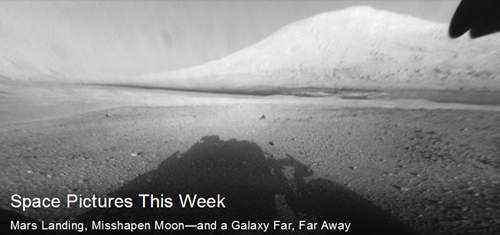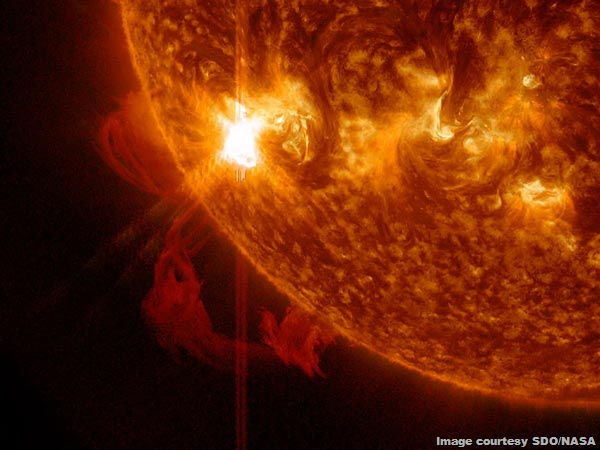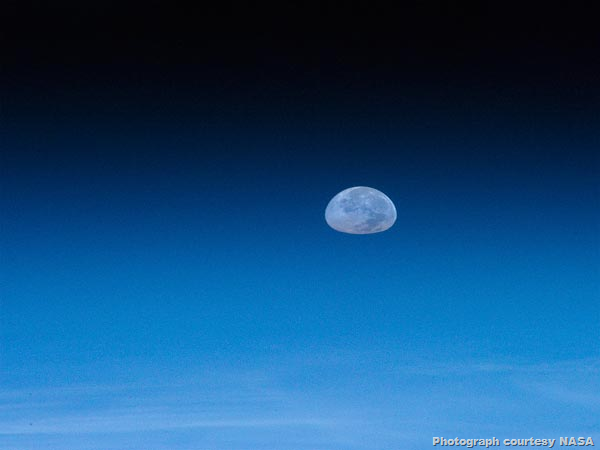

Space Pictures This Week: Mars Touchdown, Odd Moon, More
By Kastalia Medrano, National Geographic News, 13 August 2012.
By Kastalia Medrano, National Geographic News, 13 August 2012.
1. First Look
Following the Curiosity rover's successful landing on Mars last week, the world held its breath for the first images the rover transmitted from the planet's surface.
One of the NASA rover's eight hazard-avoidance cameras shot this black-and-white picture of Curiosity's own shadow stretching toward Mount Sharp on August 6.
Cantered in Gale Crater, the 18,000-foot (5,500-meter) peak "is taller than any mountain in the lower 48 [U.S.] states," geologist John Grotzinger, part of the Curiosity team, said at a July 16 press conference.
The goal is for the rover - also called the Mars Science Laboratory - to climb Mount Sharp and analyze layers spanning all of Mars's major geological epochs.
2. Sun Storm
A small sunspot called AR1538 (pictured) spewed more than a dozen flares at a rate of nearly one per hour between July 30 and 31, as captured by NASA's Solar Dynamics Observatory.
AR1538 is experiencing a heightened period of activity because of tension in the sun's magnetic field.
In a process called magnetic reconnection, magnetic loops along the sun's surface are pulled into a collection of stronger loops, leaving loose ends of unconnected magnetic lines.
When the electrons in these rogue lines hit plasma, the resulting reaction is known as a solar flare.
3. Misshapen Moon
Distortion by Earth's atmosphere gives an elliptical appearance to the August 1 full moon, as seen from the International Space Station.
4. The Heat Is On
A heat shield is subjected to punishing testing at the Arnold Engineering Development Centre in Tennessee in a recently released picture.
The shield is one of several under scrutiny for NASA's Orion Crew Exploration Vehicle, which will be the flagship of the next-generation U.S. space fleet.
Though Orion resembles its Apollo-era predecessors, the two vehicles' "technology and capability are light-years apart," according to NASA. For instance, Orion will feature a larger, more advanced crew module suitable for long-term spaceflight.
5. Galaxy Far, Far Away
In an August 2 Spitzer Space Telescope picture of spiral galaxy M100, blue represents cooler matter, while pink indicates hotter material, particularly in the galaxy's spiral arms.
Studying the M100's size and position is helping astronomers calculate the date of the big bang.
6. Burning Bright
Wildfires blaze in eastern Siberia in an August 3 satellite picture snapped by NASA's Visible Infrared Imaging Radiometer Suite. The bright, squiggly lines are flames, while smoke is seen in light grey.
The instrument is so sensitive to low light that it can detect wildfires at night - a useful tool for estimating the sizes and extents of fast-moving blazes. (See more wildfire pictures.)
7. Mission Accomplished
Joyous NASA engineers hug and cheer at receiving confirmation of the Curiosity rover's Mars landing on August 5.
Curiosity will roam the planet's surface for the next two years, transmitting data that could help scientists extrapolate whether life existed on the red planet.







No comments:
Post a Comment
Please adhere to proper blog etiquette when posting your comments. This blog owner will exercise his absolution discretion in allowing or rejecting any comments that are deemed seditious, defamatory, libelous, racist, vulgar, insulting, and other remarks that exhibit similar characteristics. If you insist on using anonymous comments, please write your name or other IDs at the end of your message.